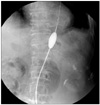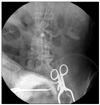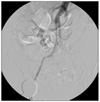Abstract
Endovascular aneurysm repairs for a ruptured AAA (EVAR for r-AAA) have been reported with limited results although endovascular aneurysm repairs for elective AAA (EVAR for e-AAA) have shown good early and late results. In this case report, the authors described successful EVAR for r-AAA. A 93-year-old female underwent emergent EVAR for r-AAA. An aortic occlusion balloon was inserted before general anesthesia for hemodynamic stability. Zenith endograft was deployed under general anesthesia. Completion angiography showed no endoleak but there was coverage of the right renal artery. She was discharged 2 weeks after overcoming transient acute renal insufficiency. We concluded that EVAR for r-AAA can be an alternative option for the treatment of ruptured AAA.
Figures and Tables
Fig. 1
CT images from the referral center showed retroperitoneal rupture from abdominal aortic aneurysm (AAA) (A), AAA of 65×59 mm in diameter (B) and aortic neck of 21 mm in diameter (C).

References
1. Parodi JC, Palmaz JC, Barone HD. Transfemoral intraluminal graft implantation for abdominal aortic aneurysms. Ann Vasc Surg. 1991. 5:491–499.
2. Prinssen M, Verhoeven EL, Buth J, Cuypers PW, van Sambeek MR, Balm R, et al. A randomized trial comparing conventional and endovascular repair of abdominal aortic aneurysms. N Engl J Med. 2004. 351:1607–1618.
3. Blankensteijn JD, de Jong SE, Prinssen M, van der Ham AC, Buth J, van Sterkenburg SM, et al. Two-year outcomes after conventional or endovascular repair of abdominal aortic aneurysms. N Engl J Med. 2005. 352:2398–2405.
4. The EVAR Trial Participants. Endovascular aneurysm repair versus open repair in patients with abdominal aortic aneurysm (EVAR trial 1): randomised controlled trial. Lancet. 2005. 365:2179–2186.
5. The EVAR Trial Participants. Endovascular aneurysm repair and outcome in patients unfit for open repair of abdominal aortic aneurysm (EVAR trial 2): randomised controlled trial. Lancet. 2005. 365:2187–2192.
6. Mehta M, Taggert J, Darling RC 3rd, Chang BB, Kreienberg PB, Paty PS, et al. Establishing a protocol for endovascular treatment of ruptured abdominal aortic aneurysms: outcomes of a prospective analysis. J Vasc Surg. 2006. 44:1–8.
7. McPhee J, Eslami MH, Arous EJ, Messina LM, Schanzer A. Endovascular treatment of ruptured abdominal aortic aneurysms in the United States (2001~2006): a significant survival benefit over open repair is independently associated with increased institutional volume. J Vasc Surg. 2009. 49:817–826.
8. Hinchliffe RJ, Powell JT, Cheshire NJ, Thompson MM. Endovascular repair of ruptured abdominal aortic aneurysm: A strategy in need of definitive evidence. J Vasc Surg. 2009. 49:1077–1080.




 PDF
PDF ePub
ePub Citation
Citation Print
Print






 XML Download
XML Download